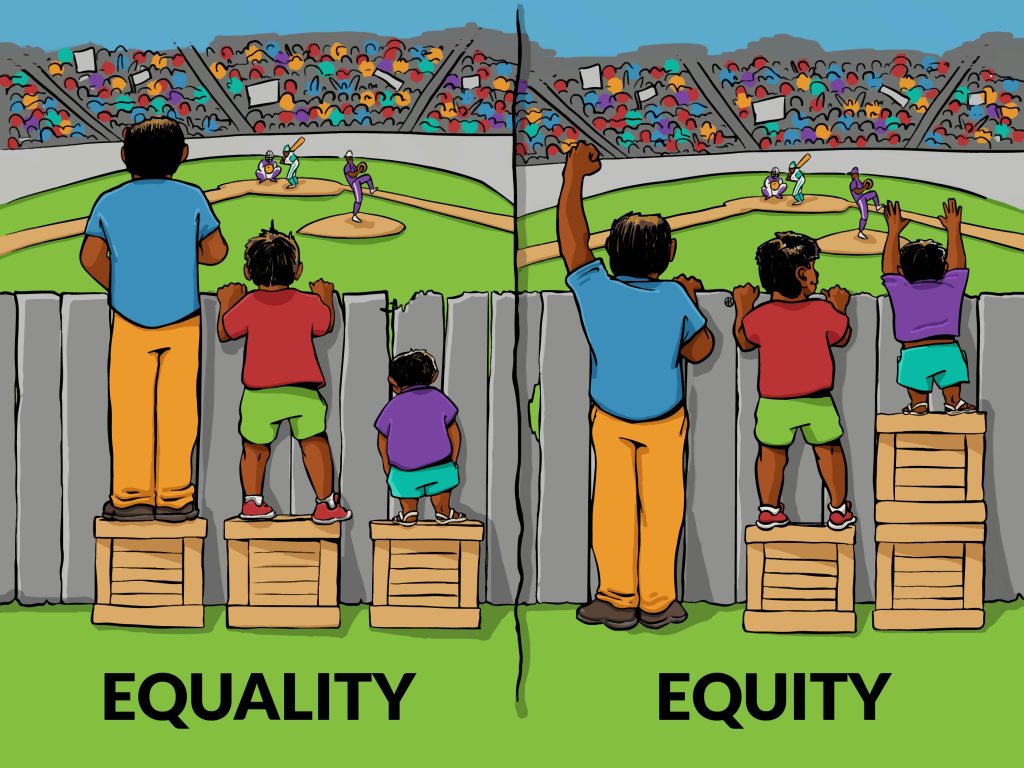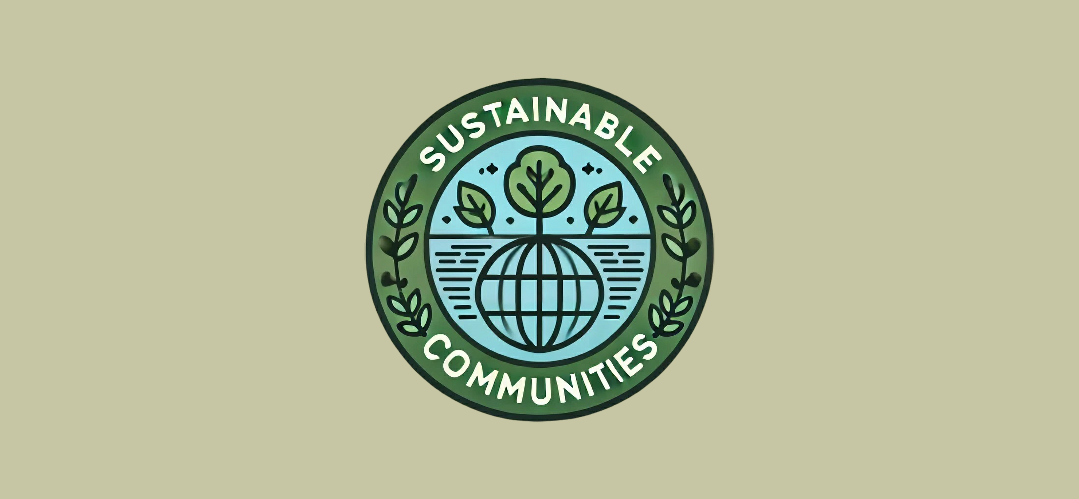By Kristi Sturtz, ALM, AICP
Read Sustainability Explained – Part 1
In recent years, a focus on equity has become an increasingly prevalent aspect of community development. But what exactly does equity mean?
Equity refers to the fair and impartial treatment of individuals, ensuring that everyone has access to opportunities, resources, and rights, regardless of their background or circumstances. Unlike equality, which focuses on treating everyone the same, equity considers the differences and disadvantages some people may face and seeks to provide tailored support to overcome those barriers. Equity recognizes that not everyone starts from the same place and works to correct the imbalances that exist.
The image below1 represents the concept. It shows three people of differing heights attempting to watch a baseball game over a fence. When all three people received equal treatment by receiving the same height box to stand on, the shortest individual still could not see over the fence. An equitable solution would be to give the shorter person a taller box. It’s about applying human-centered design by adjusting the approach according to individual needs.

The Importance of Equity in Community Planning and Development
In relation to community planning and development, equity works to ensure that individuals have access to essential services, safe environments, and economic opportunities. It involves making decisions that prioritize the needs of underserved communities and working to reduce disparities in living conditions and opportunities. The American Institute of Certified Planners Code of Ethics2 and Professional Conduct details how equity should be considered by community planners as stewards of the public good.
Equity is important because it fosters a more inclusive and just society. When individuals and communities have access to opportunities and resources, they are better positioned to thrive and contribute to society. Equity promotes social cohesion by addressing and reducing disparities, which can lead to social tensions and conflicts. Moreover, equitable policies and practices often result in better outcomes for everyone, not just those who are disadvantaged, as they create a more productive and harmonious society.
A Sample of Equity Issues and Potential Solutions
Equity issues encompass a broad range of concerns with social, economic, and environmental dimensions. Below are examples of inequitable situations and lists of potential interventions.
Redlining in American Cities
In the 1930’s, a U.S. federal agency, the Home Owners Loan Corporation (HOLC)3, developed residential security maps for mid-to-large cities across the United States. These maps were used by banks and real estate professionals to determine the risk of mortgage default. These maps identified areas as HIGH risk or “Hazardous” based on several factors including race and economic status in the area. People in these areas were “redlined” or denied the ability to purchase homes and establish multi-generational wealth for their families through homeownership. Approximately 74% of neighborhoods that were redlined decades ago remain low-to-moderate income today, and approximately 64% are considered minority neighborhoods.
Potential Interventions
Provide downpayment assistance.
Establish community land trusts.
Remove zoning barriers re: density, minimum home sizes, and accessory dwelling units.
Provide financial literacy training.
Enable entrepreneurship.
Barriers to Opportunity in Rural America
While rural areas provide a preferred lifestyle to many, the geographic separation from urban areas does have a downside in terms of access to resources, services, and economic opportunities.4 Since 1980, 85% of the rural counties in the United States have a population of over 20% that has experienced persistent poverty. Over the last several decades, economic decline has occurred in 29% of rural counties with economies that are dependent on the farming and mining sectors. In addition, stagnation has occurred in 30% of counties with economies based on manufacturing and/or the government.
Rural areas also disproportionately struggle with several health issues including obesity, opioid use, certain types of cancer, dementia, and more. Within rural communities, there are also disparities. For example, the rural American Indians/Alaskan Native population ranks highest in terms of child mortality, depression, smoking, domestic violence and heart disease, while rural African Americans rank highest in terms of obesity.
Potential Solutions
Establish collaborative public-private frameworks to leverage limited resources and advocate for community causes.
Employ a bridging agent to actively build capacity and connection.
Conduct public education campaigns regarding resources and opportunities.
Increase broadband access.
Increase transportation alternatives.
Hold satellite health fairs, nutrition classes, and medical clinics.
Climate Rights of Children and Future Generations
The definition of sustainability is to meet the needs of the present without compromising the ability of future generations to meet their own needs. This speaks to the concept of intergenerational equity which is a significant aspect of the climate crisis. The world’s children of today and those yet to be born will experience the impacts of the climate crisis much more severely than the existing adults that are in power. The UNICEF report, “The Climate Crisis is a Child’s Rights Crisis”5 explains that approximately 1 billion children currently live in countries with high risk factors associated with climate change. Risk factors include extreme temperatures, water scarcity, riverine and coastal flooding, disease vector exposure, pollution, and more.
Potential Solutions
Reduce greenhouse gas emissions.
Advocacy and activism by children and adults.
Invest in sustainable sourcing of water, sanitation and hygiene (WASH).
Increase sustainability education.
Invest in health and nutrition services.
Reduce poverty and associated vulnerability.
Achieving Equity
Achieving equity requires a deliberate and ongoing effort. It involves challenging existing norms, policies, and practices. It requires listening to marginalized voices and understanding the unique challenges they face. Governments, organizations, and individuals all have a role to play in advancing equity, whether through policy changes, advocacy, education, or personal action.
Equity is about fairness, justice, and acknowledging the diverse needs of individuals and communities. It’s about leveling the playing field so that everyone has a genuine opportunity to succeed. By embracing equity, we can work towards a world where everyone, regardless of their background, can achieve their full potential.
- “Interaction Institute for Social Change | Artist: Angus Maguire.” www.interactioninstitute.org and www.madewithangus.com . ↩︎
- American Planning Association. AICP Code of Ethics. ↩︎
- National Community Reinvestment Coalition. https://ncrc.org/holc/ ↩︎
- Robert Wood Johnson Foundation. https://www.rwjf.org/en/insights/our-research/2022/06/advancing-health-equity-in-rural-america.html ↩︎
- UNICEF. https://www.unicef.org/reports/climate-crisis-child-rights-crisis ↩︎


